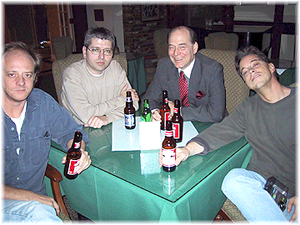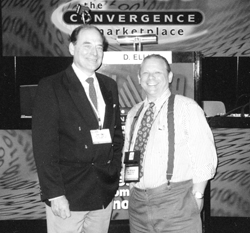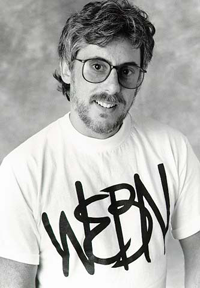By Tom Richards
We’re kindred souls on a quest for others who’ve been blessed—or is it cursed—with that precious, elusive quality, “creativity.”
Face it—we’re creative types; somehow slightly different than others. So many people have so little understanding about what we do; even those we work with…sometimes even ourselves.
So when we find someone who actually does get it, we’re captivated—“hey, here’s someone who speaks my language!” And you’re eager to hear his stuff. After all, do you suppose that when Sting got those “hundred million bottles washed up on the shore,” he didn’t read them? Inconceivable! When you crave audio production, you devour it. Yet, some of radio’s top imaging guys claim they don’t listen to their competition. Why?
 Clarification, please?
Clarification, please?
Maybe we need to make a distinction here. Let’s stipulate that there’s a difference between listening to your competition and copying them. And let’s further take it as a given that nobody ever rises to Number One by merely copying the guy who’s already there. And every self-respecting producer may hear something on, say, the RAP CD that he or she might think is moderately creative and that a similar approach might not be inappropriate in their own market, many miles away. Let it be known that the self-respecting producer would always be prudent to ask the Almighty to strike him down if he were to ever steal the product of a fellow creative type’s blood, sweat, and tears.
Hey, we all need help sometime. Ours, after all, can be a lonely job. When it comes time to be creative, there’s often nothing but our imagination and our computer, or DAW, or whatever you use. And while that’s not always a happy place to be, it’s where we choose to be, isn’t it? After all, this is where the rubber meets the road, where you’re pitching your reputation and creative mettle against that abyss, that void, that un-nameable glob that would swallow life itself if not for the heroic effort of a slightly demented producer who thinks he’s got something to say.
The Flip Side
Okay, so we hold the creative producer in high esteem. Does that mean we love everything we hear? Do we take it all at face value? Of course not. This fellowship also has a down side. We judge. We criticize. We sometimes need to feel superior. How many times have you listened to the RAP CD and snorted, “sheesh, I could beat the pants off of that promo, that spot, that ID.” Fair enough—why not send in your submission? What’s that? Feeling a little insecure, bunky? As if suddenly you’re not so sure you’re all that good?
Welcome to the club! The good news is that Radio and Production shines the blazing light of reason on the little places where fear and loathing hide, and coaxes them out with the assurance that our love for great radio production is greater than our own insecurity—hard as that is, sometimes, to believe.
So to help get you started, we’ve outlined some successful production artists, focusing in particular on their creative method—not so much on what their stuff sounds like, but on the work that occurs before the mic is even opened. These are guys who aren’t afraid to get their hands dirty, and their nose a little bloody. Hell, they’re heroes.
 Getting Down to Cases
Getting Down to Cases
In Los Angeles, KFI-AM’s Don Elliot has long been at the forefront of creative radio production. He’s made a career out of taking the road less traveled, and his creative risk-taking has paid off with countless successful media campaigns. When it comes to being creative, Don seems to take it all in stride. In fact, he has a diverse arsenal of techniques to bolster creativity, not the least of which is brainstorming.
Brainstorming? Hold on! What about all that “tortured artist/lone gunman” imagery we used just a minute ago? Fagedaboudit! For Don, creativity is a meal best shared among trusted associates, like David Hall and Don’s occasional writing partner, Anthony Pulcini. He also gives props to his posse at KFI—“the greatest staff I’ve ever worked with, including [fellow RAP Awards finalist] Ray Avila, along with Gil Perez, and Mark Drummond.
If you talk with Don, eventually you’ll hear him use the phrase “in the moment.” In our context, it has to do with virtually “living” the product, of asking yourself, “what would it be like if this thing actually worked in my own life?” And that’s the point where you enter the “back story,” which Don describes as “what happened just before the first sentence of this script.” The deeper you explore that question, the more harmonics your script develops, till you’re engaging the listener—and yourself—to the extent that they’ll literally nod their head in recognition of the little world you’ve created for them. It’s an idea similar to the approach of “Radio Ranch” honcho Dick Orkin, who once again this year is mounting, with Dan O’Day, The International Radio Creative & Production Summit in Los Angeles (www.danoday.com/summit.shtml). If you’re a radio person with even the slightest interest in radio creative, you’ll congratulate yourself abundantly for having the good sense to attend the next one.
Meanwhile, another bullet in Don Elliot’s gun is the Creative Problem Solving Institute (www.cef-cpsi.org) in Buffalo, NY, where, among other things, they help teach how to brainstorm. Don attends every June. And let’s point out that CPSI is not necessarily for us media types but rather for, according to their website, “individuals who are discovering their own creativity and learning to apply it to their own challenges.” Sometimes that’s radio people, right?
Another couple of Elliot techniques is the “forced connection,” where you make two disparate lists, choose one item from each, and make them fit; and the Y-Ching-like “dictionary” technique, where you choose a word at random and find a way to relate it to your subject. I’d be willing to bet that there are more people per capita in Los Angeles that would use this method than in, say, Kansas City, but I could be wrong.
 The Philadelphia Story
The Philadelphia Story
While we’re heading east, let’s stop in Philadelphia at the heritage rock station, WMMR. For over twenty years, spanning several PDs and countless jock arrivals and departures, the one constant at WMMR has been the imaging of Creative Services Director Steve “Lush” Lushbaugh, another finalist in this year’s RAP Awards. Although he’s pretty modest about it, Steve’s voice, both on-mic and through his creative ProTools productions, has been a major influence on the identity of the station, which remains well-positioned after over 30 years of rock music.
Yet today, despite your garden-variety fierce competitive situation, Steve says he doesn’t go out of his way to listen to other production guys; he’d rather please himself, which is “almost as random as being hit by a comet!” His ideas “can come from anywhere, like a current TV show, or writing new lyrics for its theme, or poking fun at some of the legal woes of guys like Eminem or Puff Daddy.” But, similar to Don Elliot, he’ll use those he trusts to provide a little inspiration—in particular, ‘MMR Production Director Kevin Gunn. The way Lush describes it, there’s liberal give-and-take, and any idea is subject to acceptance, revision, or flat-out rejection, without risk of damaging anybody’s ego.
Sometimes, though, the ideas just don’t seem to want to come, and he’ll either “panic in front of my computer for an hour, or just do some drudge work, like backing up my files—that won’t tax my brain all that much.” At the same time, “sometimes I’ll be doing a routine, repetitive task, like, say, washing the dishes, and an idea will come to me, and I’ll say, ‘Oh, I can’t forget that one!’ So I’ll run and leave myself a voice-mail that I can get the next day.”
Clearing out the brain brings up the role of the subconscious in creativity. Some like to pretend they’re not working on a problem by doing some kind of physical work or recreation, where they’re not concentrating on the challenge, but rather letting it simmer, to be attacked at another time, hopefully in the not-too-distant future. Others claim they use “directed sleep” for specific problem-solving tasks, where they concentrate on their challenge before and during sleep, and wake up with the solution. Steve Lushbaugh’s not one of them, though. “When I come in from a nice weekend riding my motorcycle, or playing a little piano and having a good time with my family, I don’t particularly feel like working! But it always seems that when I’ve been up late helping my son with his homework, and I come in and have three promos to do and no ideas, something seems to happen. Maybe it’s the adrenaline or the panic, but that’s when I’m at my best. Go figure.” Either way, he says, “I’ve been fortunate to have had some excellent creative relationships over the years here, and that’s really helped keep it going.”
While WMMR’s Steve Lushbaugh cops to only a casual listen to his counterparts at other stations, Christopher O’Brien studies them like a general about to go to war. Chris recently left WYSP Philadelphia after 2½ years to join the imaging team at XM Satellite Radio in Washington, DC. And once his promos get on the satellite, it’ll be like Star Wars all over again. “I consider myself a race car driver—I’d rather take a turn a bit too fast than entirely too slow.”
Chris wasn’t bitten by the radio bug—he was infected by it. So much so that he grew up spending hours in his room, listening to imaging guys before they were even called that, and duplicating the sounds he heard on his radio with a four-track Portastudio cassette machine. And damned if he didn’t nail it. Back then, nobody ever told Chris that you needed a Harmonizer to get delay, flange, and all the others; he just wrapped a little Scotch tape around his capstan, and voila!
After landing his first radio gig at the Jersey shore, Chris grabbed the opportunity to intern at WIOQ Philadelphia under then-PD Mark Driscoll and Creative Services Director David Jay. It was a front-row seat at one of the most creative radio teams ever as Driscoll and Jay shot Q102 to a position so far beyond the mainstream that we’re still trying to catch up today. Today, David Jay, now at KBIG and KOST Los Angeles, remains an O’Brien mentor. “He just nails it all the time. Perfectly!”
Once it was time to move on from New Jersey, Chris joined Soundbyte Digital Audio Production in Philadelphia, left behind his little Portastudio for ProTools, and began crafting audio that took no prisoners. By the time he got to WYSP, his skills exploded with an all-out assault on the active rock audience’s sensibilities. Beat matching, drops, obscenely effected voices, and the most aggressive imaging ever heard in the City of Brotherly Love. He says, “I just think that if it doesn’t just make you go ‘what the hell?’ then what’s the point? It just sends your audio into that giant blender we call a stop set. However, if you stick a big old heavy rock in there, it’ll be hard to get chopped up. I, in fact, strive to rip the blades off the blender. If you can do that, you know you have a winner!” And to think XM Satellite Radio’s threatening to spread him across the globe. Somebody ought to call an emergency session of the United Nations’ Security Council before it’s too late.
The Christopher O’Brien creative method cuts a wide path. “I look at the copy and then look around the room or a book or anything, and the first inanimate object that I focus on is most likely going to be the star of the promo. Anything from a rug to a trash can.” The spontaneity continues: “I’ll call up a production buddy and tell him this great idea I had for a promo—one I thought up right at that moment! [I’ve actually heard him do this. He thought he fooled me.] It never fails. After all, we can’t not have an idea when we’re talking to another production buddy. So why not use it?”
Chris’ buddies are all over. He’s not shy about picking up the phone and cold-calling a production guy who’s caught his attention. Among them are Oscar-winning Skywalker Sound designer Gary Rydstrom, WKTU New York’s Bill Schultz, and former WXRK New York CSD Brian Kelsey. “He does his thing and doesn’t care about what people think. After all, ideally, a great promo should make your PD question why he hired you!”
 “I’ll Have a Three-Way, Please”
“I’ll Have a Three-Way, Please”
We’re not quite sure who hired Joel Moss at heritage rocker WEBN Cincinnati (www.webn.com), but it was a lonnnnnnng time ago—30 years. There’s barely anything he hasn’t heard, but still he keeps at it and cites Phil Hendrie’s syndicated show and Ann DeWig of DC101 as current performers who’ve caught his attention. “What doesn’t impress me, though, is this cookie-cutter, tech-driven production that relies on stutters and drops. It’s just a 15-year-old’s mentality, and there’s nothing really there for me,” he says. “And despite all the technology available to us today, writing is still paramount.” For both Joel and Steve Lushbaugh, Firesign Theater’s albums provide an example of maximum impact—“both production and incredible writing. They just worked so well together—like a jazz quartet, improvising around a theme, and supporting whoever’s ‘soloing’ at the moment.”
In fact, Joel’s surrounded by creative support from “almost everyone at the station, including everyone from the Dawn Patrol morning show, the promotions department, to Jay Gilbert, our afternoon drive guy. Jay’s also an incredibly talented musician, so he helps me with song parodies.”
Joel also uses Sonic Foundry’s ACID loops for his musical explorations, along with custom loops. And, after holding onto his Roland DM-800 way beyond the call of duty, he’s switched to the Sonic Foundry suite, including Vegas Audio 2.0b multi-track, and Sound Forge 5.0. “They opened my eyes,” he says, “and totally reinvigorated my production style and even enjoyment in actually producing pieces.” He also uses AVDeli production music.
But those are just the tools. The way Joel uses them helps define The Frog in Cincinnati with in-your-face imaging. He’s also not afraid to provoke controversy in the city that prosecuted Hustler editor Larry Flynt and Robert Mapplethorpe’s photographs. The Frog has nothing to do with playing it safe. And when someone calls to complain about something they heard, Joel shrugs it off. “We pretty much thank them for calling, and forget about it.” It’s the reaction that counts. “It’s the intimacy of radio,” he says. “We take advantage of localization to enhance the immediacy of the response.” It’s what’s kept him at The Frog along with “discipline, setting and meeting self-goals, knowing what’s coming, and anticipating the needs of the radio station.” He also feels a responsibility to mentor young talent. But before you rush out to intern at WEBN, better make sure you’re up to it. “I’m looking for the young guys to teach me something. Eric Chase from WFLA Tampa (www.970wfla.com/downloads.html) struck me as a terrifically talented guy, somebody who doesn’t mind putting in the hours. Anything short of that, and I’m not really interested.” Does he listen to his competition? “I pretty much don’t bother.”
The Difference
So you’ve heard from four of the best we’ve got. What’s my take? First off, I choose my collaborators carefully; it takes a lot for me to reach such a level of trust that I’ll share creative direction. My method is to do a little stealth research—ask people in the office about what they might feel about a particular type of product, or TV show, or whatever I’m looking to write about. Depending on the reaction I get, I’ll abandon my idea, revise it, or just go balls to the wall if I think I’m on track. And that’s all within the solitude of my little studio.
That doesn’t mean I can’t collaborate, though, if I’m on the same wavelength with someone else. My Program Director, Mark Edwards, and I recently whipped up some promos to attack our competition in the market—an oldies station—using sound bites and production music from NBC’s new “The Weakest Link.” For Mark and me, it was a no-brainer, and the ideas just kept flowing. It was delicious!
But I think I understand what Don Elliot, Steve Lushbaugh, Christopher O’Brien, and Joel Moss are saying. These are guys who have made the transition from a “borrower” to a “doer.” They’ve made the jump to trusting their impulses, acting on them, and giving us some great radio creative in the process. They’re leaders, not followers.
The way I see it, creativity is like the ocean. Some people go near it, but never in it. Some go in up to their ankles, others to their waist. And still others dive right in and let it wash all over them. May it always be so for you.
♦
POST PUBLICATION CORRECTION: [The above article] contained two incorrect statements regarding Joel Moss. Joel was kind enough to clarify them for us.
1) Joel has NOT been at WEBN for 30 years. Joel writes, “…while I started in radio some thirty years ago at WLIR, my pit stops included Boston, Denver and Boulder, Colorado, and back to New York for a brief lube job and rotation at WNEW FM [1979-80]. I finally landed at WEBN in 1984, and have been audio mechanic in residence ever since.”
2) When asked if he listens to his competition, “I pretty much don’t bother” was NOT his answer. Joel clarifies: “Nothing could be farther from the truth. On the contrary, work by those mentioned in the article such as Ann DeWig, and more recently John Frost, and others, continues to inspire and push me to find new ways of doing the same thing. As others mentioned in the article, I “devour” samples of producers’ creations. Sometimes it hurts to hear something so incredible, but, as I said, hopefully, it pushes me somewhere I may not have gone.”
Our apologies to Joel and thanks for clearing things up for us!
♦

